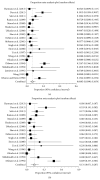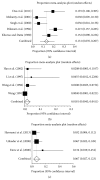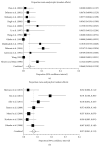Prevalence of Budd-Chiari Syndrome during Pregnancy or Puerperium: A Systematic Review and Meta-Analysis
- PMID: 26457079
- PMCID: PMC4592727
- DOI: 10.1155/2015/839875
Prevalence of Budd-Chiari Syndrome during Pregnancy or Puerperium: A Systematic Review and Meta-Analysis
Abstract
Women during pregnancy or puerperium are likely to develop Budd-Chiari syndrome (BCS). However, the reported prevalence of pregnancy-related BCS varied considerably among studies. Our study aims to systematically review this issue. Overall, 817 papers were initially identified via the PubMed, EMBASE, China National Knowledge Infrastructure, and Chinese Scientific and Technological Journal databases. Twenty of them were eligible. The prevalence of pregnancy-related BCS varied from 0% to 21.5%. The pooled prevalence was 6.8% (95% CI: 3.9-10.5%) in all BCS patients, 6.3% (95% CI: 3.8-9.4%) in primary BCS patients, and 13.1% (95% CI: 7.1-20.7%) in female BCS patients. Among them, one study was carried out in Africa with a prevalence of 10.6%; 14 studies in Asian countries with a pooled prevalence of 7.1% (95% CI: 3.1-12.6%); and 5 studies in European countries with a pooled prevalence of 5.0% (95% CI: 3.1-7.3%). The pooled prevalence was 6.7% (95% CI: 2.6-12.3%) in studies published before 2005 and 7.3% (95% CI: 4.2-12.5%) in those published after 2005. In conclusion, pregnancy is a relatively common risk factor for BCS, but there is a huge variation in the prevalence among studies. Physicians should be aware of pregnancy-related BCS.
Figures






References
-
- Murad S. D., Plessier A., Hernandez-Guerra M., et al. Etiology, management, and outcome of the Budd-Chiari syndrome. Annals of Internal Medicine. 2009;151(3):167–175. - PubMed
-
- Qi X., De Stefano V., Wang J., et al. Prevalence of inherited antithrombin, protein C, and protein S deficiencies in portal vein system thrombosis and Budd-Chiari syndrome: a systematic review and meta-analysis of observational studies. Journal of Gastroenterology and Hepatology. 2013;28(3):432–442. - PubMed
-
- Qi X., Ren W., De Stefano V., Fan D. Associations of coagulation Factor V leiden and prothrombin G20210A mutations with budd-chiari syndrome and portal vein thrombosis: a systematic review and meta-analysis. Clinical Gastroenterology and Hepatology. 2014 doi: 10.1016/j.cgh.2014.04.026. - DOI - PubMed
Publication types
LinkOut - more resources
Full Text Sources
Other Literature Sources

